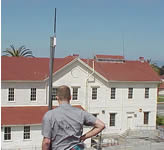 |
|
|
|
An "off the shelf" and license free wireless networking technology (802.11b) may soon win the first round in the wireless war. Better know wireless technologies such as Bluetooth, or WAP, have been touting a wonderful wireless future ...if only the world were to adopt their standards. Once we're all on the "same song sheet" (and of course it's their song sheet they want you to be on), they promise that all of the benefits will simply fall into place and the elusive wireless dream will be realized. Yet neither WAP nor Bluetooth has taken over the world; in fact there is a good chance that neither will succeed, considering the growth of a new wireless data networking standard, cryptically called 802.11b. 802.11b has been quietly gaining ground on the more widely touted ways of gaining wireless access to the Internet. The Institute of Electrical and Electronics Engineers (IEEE) assigned the open standard wireless networking technology the specification of 802.11b, (pronounced: eight-oh-two dot eleven-bee) however the nick name "WiFi" is gaining in popularity. WiFi uses an unlicensed spectrum at 2.4 gigahertz, a frequency that is shared by microwave ovens and cordless phones, .. and a frequency that anyone can use for free. And use it is just what people are starting to do! And in surprising ways. In a movement that is reminiscent of the beginning of the open source software projects, individual wireless networking enthusiasts are joining forces in London, San Francisco, Cambridge Mass., New York, NY and other cities around the globe, and are developing and deploying free high speed wireless networks that anyone with a network card can access. It seems wireless communities are springing up all over.
But 802.11b is not just for enthusiasts and hobbyists. Corporations are getting into the game as well. In January 2001 Microsoft and Starbucks entered into an agreement to "WiFi" Starbucks locations "through-out-land", within the next two years. The PDA toting, Java sipper will soon peruse email, surf the net or download an app, at speeds that cook! WiFi is true wireless broadband. In November 1999, the IEEE ratified the 802.11b standard for wireless data connections of up to 11 megabits per second—200 times faster than the average PC modem. And the high speed capabilities are attracting the attention of organizations, corporations and educational institutions like MIT. MIT may soon be the first "WiFi" campus. And companies have begun installing the equipment in airports, hotel lobbies and sports stadiums. And now ISPs are looking into providing "low cost" high speed wireless services. But all of this activity is not with out some drawbacks. The 2.4 gigahertz frequency can be a crowded place, with all the cordless phones, baby monitors, streetlights and microwave ovens sharing the space. It also will not work if you're in a moving vehicle, so the wireless phone companies need not worry about about 802.11b threatening their existing services. These technological drawbacks notwithstanding, the future of WiFI looks bright and exciting. The open source software movement stimulated one of the most creative periods in software engineering and the same creative energy is at work building the people's wireless broadband network.
|
||||||||
© 2001 PDA cortex.
All Rights Reserved
IT's Cutting Edge

